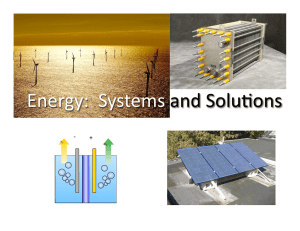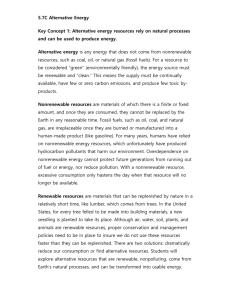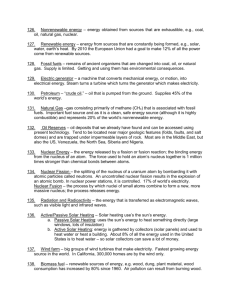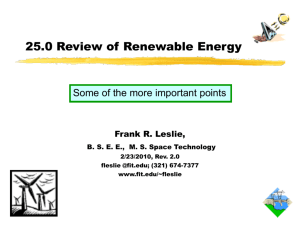Renewable Energy Chapter Test - Holt Environmental Science
advertisement
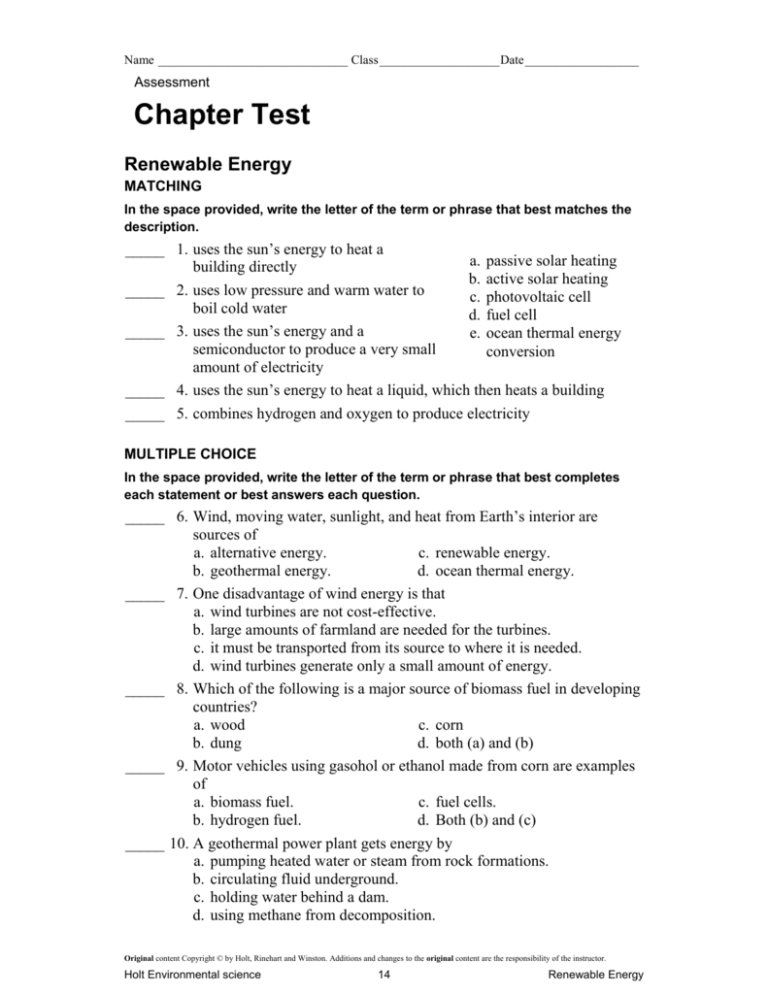
Name ______________________________ Class ___________________ Date __________________ Assessment Chapter Test Renewable Energy MATCHING In the space provided, write the letter of the term or phrase that best matches the description. _____ 1. uses the sun’s energy to heat a a. passive solar heating building directly b. active solar heating _____ 2. uses low pressure and warm water to c. photovoltaic cell boil cold water d. fuel cell _____ 3. uses the sun’s energy and a e. ocean thermal energy semiconductor to produce a very small conversion amount of electricity _____ 4. uses the sun’s energy to heat a liquid, which then heats a building _____ 5. combines hydrogen and oxygen to produce electricity MULTIPLE CHOICE In the space provided, write the letter of the term or phrase that best completes each statement or best answers each question. _____ 6. Wind, moving water, sunlight, and heat from Earth’s interior are sources of a. alternative energy. c. renewable energy. b. geothermal energy. d. ocean thermal energy. _____ 7. One disadvantage of wind energy is that a. wind turbines are not cost-effective. b. large amounts of farmland are needed for the turbines. c. it must be transported from its source to where it is needed. d. wind turbines generate only a small amount of energy. _____ 8. Which of the following is a major source of biomass fuel in developing countries? a. wood c. corn b. dung d. both (a) and (b) _____ 9. Motor vehicles using gasohol or ethanol made from corn are examples of a. biomass fuel. c. fuel cells. b. hydrogen fuel. d. Both (b) and (c) _____ 10. A geothermal power plant gets energy by a. pumping heated water or steam from rock formations. b. circulating fluid underground. c. holding water behind a dam. d. using methane from decomposition. Original content Copyright © by Holt, Rinehart and Winston. Additions and changes to the original content are the responsibility of the instructor. Holt Environmental science 14 Renewable Energy Name ______________________________ Class ___________________ Date __________________ Chapter Test continued _____ 11. Flooding of habitats, disruption of ecosystems downstream, and reduced productivity of farmland are disadvantages of a. geothermal energy. c. hydroelectric energy. b. ocean thermal energy. d. tidal power. conversion. _____ 12. What would increase energy efficiency in the United States? a. using public transportation and developing more efficient engines for vehicles b. turning thermostats down in winter and up in summer c. insulating homes and businesses d. all of the above _____ 13. Which of the following is a source of alternative energy? a. wind turbines c. solar collectors b. hydroelectric dams d. hydrogen fuel _____ 14. The most energy-efficient vehicles available today are a. cars with gasoline engines. c. fuel cell cars. b. hybrid cars. d. cars that use biomass fuel.] _____ 15. Geothermal heat pumps can heat homes by a. circulating fluid underground to absorb heat from Earth. b. pumping hot water or steam from deep underground. c. using underground rivers to turn a small turbine. d. All of the above _____ 16. Which element might be the fuel of the future? a. oxygen c. nitrogen b. carbon d. hydrogen _____ 17. The percentage of energy put into a system that does useful work is a. energy conservation. c. energy efficiency. b. renewable energy. d. energy conversion. _____ 18. A lifestyle change that can help conserve energy is a. using incandescent lights. c. using less of any resource. b. buying the cheapest gas. d. Both (a) and (c) _____ 19. Which of the following is a disadvantage of ocean thermal energy conversion? a. not enough cold water c. not enough warm water b. inefficient plants d. can only be done in cold areas _____ 20. A heat exchanger is used in a. active solar heating. c. geothermal power plants. b. passive solar heating. d. wind turbines. Original content Copyright © by Holt, Rinehart and Winston. Additions and changes to the original content are the responsibility of the instructor. Holt Environmental science 15 Renewable Energy TEACHER RESOURCE PAGE renewable energy and relatively nonpolluting. Students should also indicate that damming rivers may damage ecosystems. Active Reading SECTION: RENEWABLE ENERGYTODAY 1. 2. 3. 4. 5. 6. 7. 8. 9. 10. 11. 12. c b d They have no moving parts and run on nonpolluting power from the sun. Today’s solar cells are more efficient and less expe nsive. c e a b Solar cells supply energy to homes, space stations, and common objects such as calculators. In developing countries, energy consumption is minimal and electricity networks are limited. Solar cells produce only a small amount of electricity; thus, acres of them would be needed to supply energy for a small city. Also, solar cells require extended periods of sunlight. Quiz SECTION: RENEWABLE ENERGY TODAY Matching 1. b 2. d 3. e 4. a 5. c SECTION: ALTERNATIVE ENERGY CONSERVATION Matching 1. b 2. a 3. d 4. e 5. c 5. 6. 7. 8. 9. 10. Multiple Choice 6. a 7. c 8. d 9. c 10. b Chapter Test General SECTION: ALTERNATIVE ENERGY AND CONSERVATION 1. 2. 3. 4. Multiple Choice 6. c 7. a 8. a 9. d 10. b MATCHING 1. 2. 3. 4. 5. d b c Energy efficiency refers to using energy without wasting it. Insulation protects homes from energy loss. c a windows, doors, walls, and the roof A person can hold a ribbon up to the edges of windows and doors. If the ribbon flutters, there is a leak. It is lost when heated or cooled air escapes through gaps around windows and doors. a e c b d MULTIPLE CHOICE 6. 7. 8. 9. 10. 11. 12. 13. c c d a a c d d 14. 15. 16. 17. 18. 19. 20. b a d c c b a Chapter Test Advanced Map Skills MATCHING 1. New York, Washington, Oregon 2. less than 3. Answers will vary depending on geographic location. 4. Answers may vary. Students should mention that hydroelectric power is 1. 2. 3. 4. 5. b c d e a MULTIPLE CHOICE 6. 7. 8. 9. 10. b c a d c Original content Copyright © by Holt, Rinehart and Winston. Additions and changes to the original content are the responsibility of the instructor. Holt Environmental science 85 Renewable Energy





